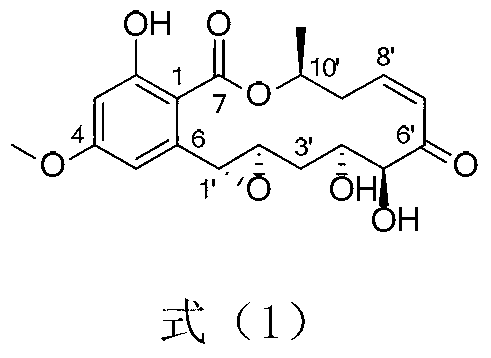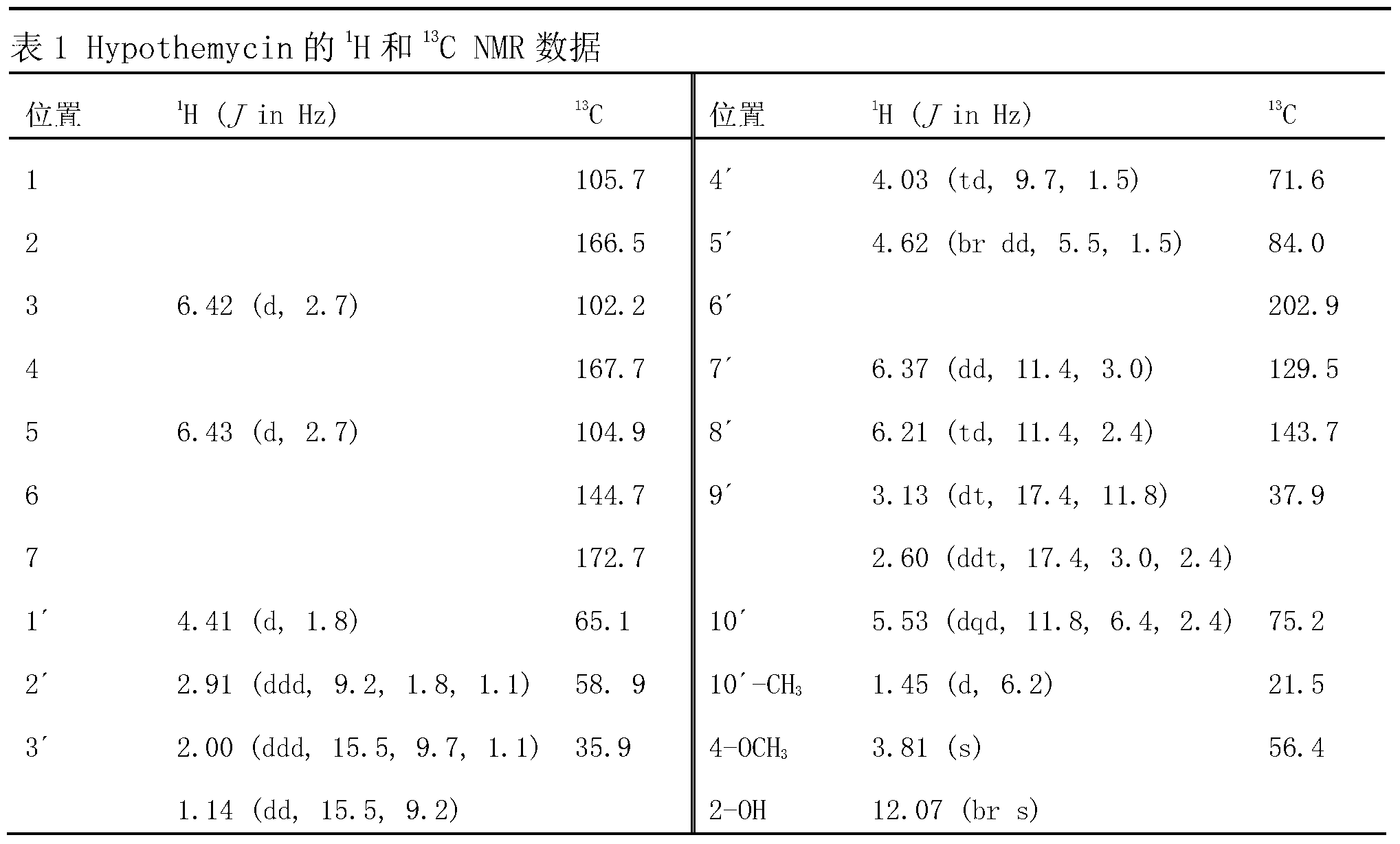Applications of macrolide compound in preventing plant downy mildew
A compound and downy mildew technology, applied in application, plant growth regulator, botanical equipment and methods, etc., can solve problems such as difficult decomposition, weakened drug effect, and drug loss
- Summary
- Abstract
- Description
- Claims
- Application Information
AI Technical Summary
Problems solved by technology
Method used
Image
Examples
Embodiment 1
[0021] Embodiment 1: the preparation of the compound represented by formula (1) of the present invention
[0022] Paecilomyces sp.SC0924CGMCC No.2900 strain was inoculated on 11.50L rice solid medium (rice and water with a mass ratio of 1:1), and cultured statically at 26°C for 22 days in the dark to obtain a solid fermentation culture. The obtained solid fermentation culture was extracted 3 times with 1.5 times the volume of 95% ethanol for 24 hours each time. After the ethanol aqueous solution was concentrated under reduced pressure to remove ethanol, it was extracted 3 times with an equal volume of chloroform, and the extract was concentrated to obtain a chloroform extract 97.50 g.
[0023] The chloroform extract was subjected to silica gel column chromatography, and the chloroform-methanol mixed solvent with a volume ratio of 100:0 to 80:20 was used for gradient elution, and the similar fractions were detected by thin-layer chromatography, and petroleum ether was collected...
Embodiment 2
[0026] Embodiment 2: The in vitro inhibitory activity experiment of the Hypothemycin obtained in Example 1 to the common pathogens of plant downy mildew --- litchi downy mildew, Pythium melon and fruit, Phytophthora melon and Phytophthora tabacum
[0027] The Pythium aphanidermatum used in the experiment was purchased from the China Agricultural Microorganism Culture Collection and Management Center, and the Peronophythora litchii, Phytophthora melonis and Phytophthora nicotianae were provided by Dr. Pan Ruqian, School of Resources and Environment, South China Agricultural University.
[0028]The anti-downy mildew activity of the compound Hypothemycin was determined by the filter paper agar diffusion method: four kinds of downy mildew pathogens including activated Phytophthora litchii, Pythium melon and fruit, Phytophthora melon and Phytophthora nicotianae were inoculated into In the petri dish with PDA solid medium, use a T-shaped applicator to evenly coat it for later use; th...
Embodiment 3
[0030] Embodiment 3: The Hypothemycin that embodiment 1 obtains is to the inhibitory activity experiment of downy mildew in litchi storage after harvesting
[0031] Test sample: the Hypothemycin obtained in Example 1 was dissolved in a small amount of ethanol, diluted with deionized water to 100, 200, and 300 μg / mL, and the final concentration of ethanol was 2.5% by volume.
[0032] Test bacteria liquid: Pythora lychee was cultured in PDA medium for 3 days, adding deionized water to wash the surface spores, counting them under a microscope and diluting them into a bacteria liquid containing about 106 spores per mL for use.
[0033] Litchi for testing: Litchi variety "Huaizhi" (Litchi chinesis Sonn.cv. Huaizhi) was collected from Conghua City, Guangdong Province. After harvesting, it was transported back to the laboratory immediately, and the processing began within 4 hours. Select fruits with the same size, no pests and diseases, and a maturity of about 8.5% (most of the peel ...
PUM
| Property | Measurement | Unit |
|---|---|---|
| Width | aaaaa | aaaaa |
| Width | aaaaa | aaaaa |
Abstract
Description
Claims
Application Information
 Login to View More
Login to View More - R&D
- Intellectual Property
- Life Sciences
- Materials
- Tech Scout
- Unparalleled Data Quality
- Higher Quality Content
- 60% Fewer Hallucinations
Browse by: Latest US Patents, China's latest patents, Technical Efficacy Thesaurus, Application Domain, Technology Topic, Popular Technical Reports.
© 2025 PatSnap. All rights reserved.Legal|Privacy policy|Modern Slavery Act Transparency Statement|Sitemap|About US| Contact US: help@patsnap.com



